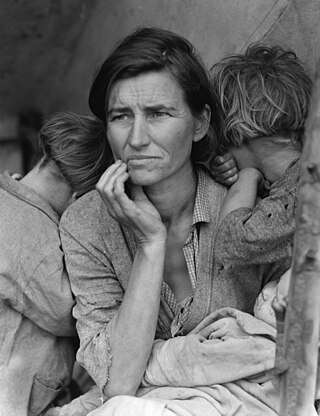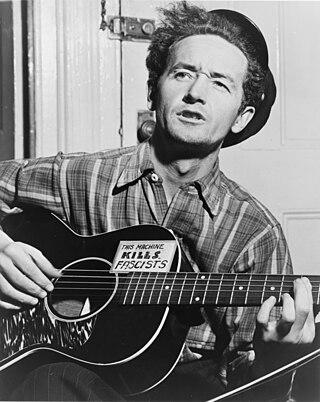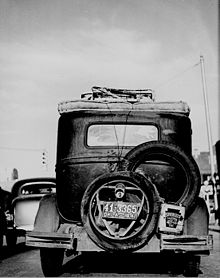
John Ernst Steinbeck was an American writer. He won the 1962 Nobel Prize in Literature "for his realistic and imaginative writings, combining as they do sympathetic humor and keen social perception". He has been called "a giant of American letters."

The Grapes of Wrath is an American realist novel written by John Steinbeck and published in 1939. The book won the National Book Award and Pulitzer Prize for fiction, and it was cited prominently when Steinbeck was awarded the Nobel Prize in Literature in 1962.

The Dust Bowl was the result of a period of severe dust storms that greatly damaged the ecology and agriculture of the American and Canadian prairies during the 1930s. The phenomenon was caused by a combination of natural factors and human-made factors: a failure to apply dryland farming methods to prevent wind erosion, most notably the destruction of the natural topsoil by settlers in the region. The drought came in three waves: 1934, 1936, and 1939–1940, but some regions of the High Plains experienced drought conditions for as long as eight years.

Weedpatch is an unincorporated community and census-designated place (CDP) in Kern County, California, United States. Weedpatch is 10 miles (16 km) south-southeast of Bakersfield. It is considered to be one of the poorest areas in Kern County. As of the 2010 census it had a population of 2,658.

The Farm Security Administration (FSA) was a New Deal agency created in 1937 to combat rural poverty during the Great Depression in the United States. It succeeded the Resettlement Administration (1935–1937).

A pea-picker is a derogatory reference to poor, migrant workers during the Great Depression. These people were unskilled, poorly educated workers, employable only in menial jobs, such as harvesting crops and, as such, received poor wages for working long hours under dreadful conditions. Some of these people were photographed by Dorothea Lange.

The Resettlement Administration (RA) was a New Deal U.S. federal agency created May 1, 1935. It relocated struggling urban and rural families to communities planned by the federal government. On September 1, 1937, it was succeeded by the Farm Security Administration.

The Grapes of Wrath is a 1940 American drama film directed by John Ford. It was based on John Steinbeck's 1939 Pulitzer Prize-winning novel of the same name. The screenplay was written by Nunnally Johnson and the executive producer was Darryl F. Zanuck.

Dust Bowl Ballads is an album by American folk singer Woody Guthrie. It was released by Victor Records, in 1940. All the songs on the album deal with the Dust Bowl and its effects on the country and its people. It is considered to be one of the first concept albums. It was Guthrie's first commercial recording and the most successful album of his career.
The Bakersfield sound is a sub-genre of country music developed in the mid-to-late 1950s in and around Bakersfield, California. Bakersfield is defined by its influences of rock and roll and honky-tonk style country, and its heavy use of electric instrumentation and backbeats. It was also a reaction against the slickly produced, orchestra-laden Nashville sound, which was becoming popular in the late 1950s. The Bakersfield sound became one of the most popular and influential country genres of the 1960s, initiating a revival of honky-tonk music and influencing later country rock and outlaw country musicians, as well as progressive country.

The Grapes of Wrath is an opera in three acts composed by Ricky Ian Gordon to a libretto by Michael Korie based on John Steinbeck’s 1939 novel of the same title. It premiered on February 10, 2007 at the Ordway Center for the Performing Arts in Saint Paul, Minnesota in a production by Minnesota Opera. The work has been revised in subsequent years and has also been performed as a two-act concert version.

"Do Re Mi" is a folk song by American songwriter Woody Guthrie. The song deals with the experiences and reception of Dust Bowl migrants when they arrive in California. It is known for having two guitar parts, both recorded by Guthrie.

Sanora Babb was an American novelist, poet, and literary editor.
Charles Jogi Shindo is a Professor of United States history at Louisiana State University.
Paul "Okie Paul" Westmoreland was a musician, songwriter, and disc jockey in Sacramento, California.

Arvin Federal Government Camp, also known as the Weedpatch Camp or Sunset Labor Camp, was built by the Farm Security Administration south of Bakersfield, California, in 1936 to house migrant workers during the Great Depression. The National Register of Historic Places placed several of its historic buildings on the registry on January 22, 1996.

The California Dream is the psychological motivation to gain fast wealth or fame in a new land. Some argue that, as a result of the California Gold Rush after 1849, California's name became indelibly connected with the Gold Rush, and fast success in a new world became known as the "California Dream", while others claim this concept did not emerge until the 1960s. California was perceived as a place of new beginnings, where great wealth could reward hard work and good luck. The notion inspired the idea of an American Dream. California was seen as a lucky place, a land of opportunity and good fortune. It was a powerful belief, underlying many of the accomplishments of the state, and equally potent when threatened.

The Harvest Gypsies, by John Steinbeck, is a series of feature-story articles written on commission for The San Francisco News about the lives and times of migrant workers in California's Central Valley. Published daily from October 5 to 12, 1936, Steinbeck explores and explains the hardships and triumphs of American migrant workers during the Great Depression, tracing their paths and the stories of their lives and travels from one crop harvest to the next crop harvest as they eked out a stark existence as temporary farmhands.
"Vigilante Man" is a song by Woody Guthrie, recorded and released in 1940 as one of his Dust Bowl Ballads.

Whose Names Are Unknown is an American novel by Sanora Babb, written in the 1930s but not published until 2004. It centers on members of a High Plains farm family during the Great Depression as they endure the poverty inflicted by drought and the Dust Bowl; they ultimately flee to California in hopes of building a better life but encounter a new set of hardships.


















